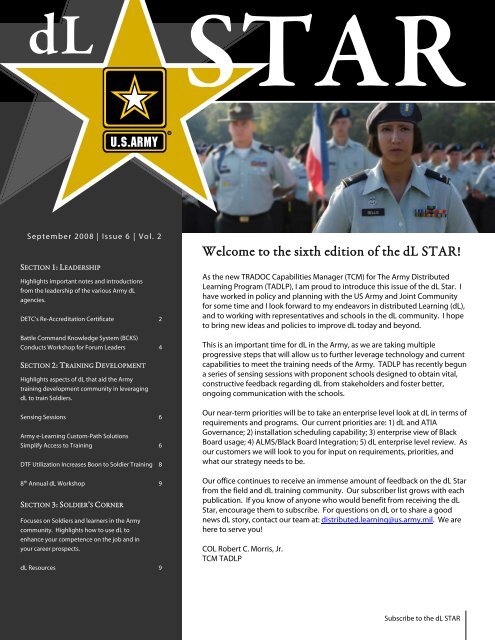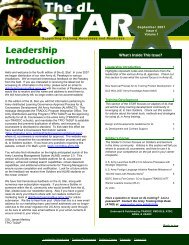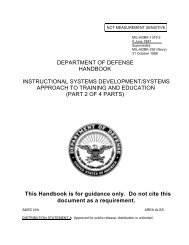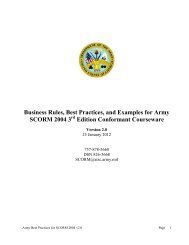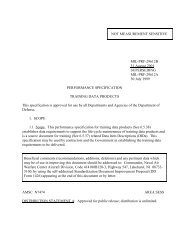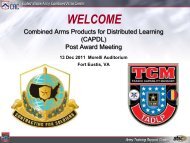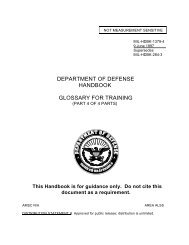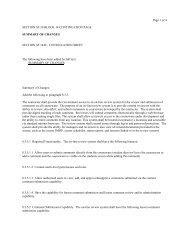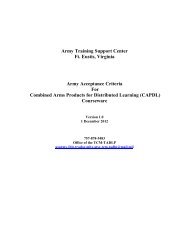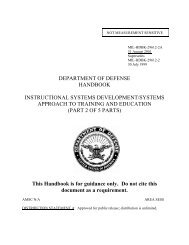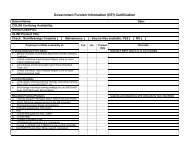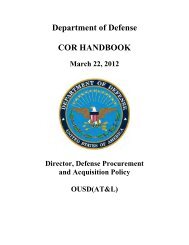the sixth edition of the dL STAR! - U. S. Army Training Support Center
the sixth edition of the dL STAR! - U. S. Army Training Support Center
the sixth edition of the dL STAR! - U. S. Army Training Support Center
You also want an ePaper? Increase the reach of your titles
YUMPU automatically turns print PDFs into web optimized ePapers that Google loves.
<strong>dL</strong>September 2008 | Issue 6 | Vol. 2SECTION 1: LEADERSHIPHighlights important notes and introductionsfrom <strong>the</strong> leadership <strong>of</strong> <strong>the</strong> various <strong>Army</strong> <strong>dL</strong>agencies.DETC’s Re-Accreditation Certificate 2Battle Command Knowledge System (BCKS)Conducts Workshop for Forum Leaders 4SECTION 2: TRAINING DEVELOPMENTHighlights aspects <strong>of</strong> <strong>dL</strong> that aid <strong>the</strong> <strong>Army</strong>training development community in leveraging<strong>dL</strong> to train Soldiers.Sensing Sessions 6<strong>Army</strong> e-Learning Custom-Path SolutionsSimplify Access to <strong>Training</strong> 6DTF Utilization Increases Boon to Soldier <strong>Training</strong> 88 th Annual <strong>dL</strong> Workshop 9SECTION 3: SOLDIER’S CORNERFocuses on Soldiers and learners in <strong>the</strong> <strong>Army</strong>community. Highlights how to use <strong>dL</strong> toenhance your competence on <strong>the</strong> job and inyour career prospects.<strong>dL</strong> Resources 9Welcome to <strong>the</strong> <strong>sixth</strong> <strong>edition</strong> <strong>of</strong> <strong>the</strong> <strong>dL</strong> <strong>STAR</strong>!As <strong>the</strong> new TRADOC Capabilities Manager (TCM) for The <strong>Army</strong> Distribute<strong>dL</strong>earning Program (TADLP), I am proud to introduce this issue <strong>of</strong> <strong>the</strong> <strong>dL</strong> Star. Ihave worked in policy and planning with <strong>the</strong> US <strong>Army</strong> and Joint Communityfor some time and I look forward to my endeavors in distributed Learning (<strong>dL</strong>),and to working with representatives and schools in <strong>the</strong> <strong>dL</strong> community. I hopeto bring new ideas and policies to improve <strong>dL</strong> today and beyond.This is an important time for <strong>dL</strong> in <strong>the</strong> <strong>Army</strong>, as we are taking multipleprogressive steps that will allow us to fur<strong>the</strong>r leverage technology and currentcapabilities to meet <strong>the</strong> training needs <strong>of</strong> <strong>the</strong> <strong>Army</strong>. TADLP has recently beguna series <strong>of</strong> sensing sessions with proponent schools designed to obtain vital,constructive feedback regarding <strong>dL</strong> from stakeholders and foster better,ongoing communication with <strong>the</strong> schools.Our near-term priorities will be to take an enterprise level look at <strong>dL</strong> in terms <strong>of</strong>requirements and programs. Our current priorities are: 1) <strong>dL</strong> and ATIAGovernance; 2) installation scheduling capability; 3) enterprise view <strong>of</strong> BlackBoard usage; 4) ALMS/Black Board Integration; 5) <strong>dL</strong> enterprise level review. Asour customers we will look to you for input on requirements, priorities, andwhat our strategy needs to be.Our <strong>of</strong>fice continues to receive an immense amount <strong>of</strong> feedback on <strong>the</strong> <strong>dL</strong> Starfrom <strong>the</strong> field and <strong>dL</strong> training community. Our subscriber list grows with eachpublication. If you know <strong>of</strong> anyone who would benefit from receiving <strong>the</strong> <strong>dL</strong>Star, encourage <strong>the</strong>m to subscribe. For questions on <strong>dL</strong> or to share a goodnews <strong>dL</strong> story, contact our team at: distributed.learning@us.army.mil. We arehere to serve you!COL Robert C. Morris, Jr.TCM TADLPSubscribe to <strong>the</strong> <strong>dL</strong> <strong>STAR</strong>
<strong>dL</strong><strong>STAR</strong><strong>Support</strong>ing <strong>Training</strong> Awareness and ReadinessSeptember 2008 | Issue 6 | Vol. 2SECTION 1: LEADERSHIPDETC’s Re-Accreditation CertificateOn Feb 27, 2008, <strong>the</strong> <strong>Army</strong> <strong>Training</strong> <strong>Support</strong> <strong>Center</strong> (ATSC)Executive Director, Mr. Lou Iorizzo, presented <strong>the</strong> Director,Individual <strong>Training</strong> <strong>Support</strong> Directorate, Dr. Connie Wardell andDivision Chief, <strong>Training</strong> Services <strong>Support</strong> Division, Mrs. CarolWashington with <strong>the</strong> Distance Education and <strong>Training</strong> Council’s(DETC) re-accreditation certificate <strong>of</strong> <strong>the</strong> <strong>Army</strong> Institute forPr<strong>of</strong>essional Development (AIPD) at Building 3306.Founded in 1926, <strong>the</strong> DETC is a non-pr<strong>of</strong>it educationalassociation and nationally recognized accrediting agencylocated in Washington D.C. Accredited institutions includedegree-granting institutions, high schools, and post-secondaryinstitutions. Besides AIPD, <strong>the</strong> DETC also accredits <strong>the</strong> MarineCorps Institute and <strong>the</strong> Air Force Institute for AdvancedDistributed Learning.The DETC re-accreditation certificate certifies that <strong>the</strong> U.S. AIPD“has been duly examined and been found to meet <strong>the</strong>Educational and Ethical Business Standards for <strong>the</strong> AccreditingCommission <strong>of</strong> <strong>the</strong> DETC on <strong>the</strong> 1st day <strong>of</strong> June 1978 and mostrecently re-accredited on <strong>the</strong> 12th day <strong>of</strong> January 2008.” Thepresentation called attention to <strong>the</strong> fact that AIPD has beenaccredited by DETC for 30 years.Formerly a directorate, AIPD is currently a virtual institutionused to assist ITSD in accomplishing its <strong>dL</strong> functions andresponsibilities in acting as <strong>the</strong> centralized hub betweenTRADOC proponent schools and <strong>the</strong> individual Soldier. The reaccreditationvisiting team noted that AIPD administered some370,000 annual enrollments in <strong>the</strong> courses managed by <strong>the</strong>institute and shipped over 170,000 courses including CD-ROMS and supplemental materials for <strong>dL</strong> courses such as maps,protractors, and o<strong>the</strong>r materials via <strong>the</strong> U.S. Postal Serviceneeded by Soldiers to complete <strong>the</strong>ir <strong>dL</strong> learning.Additionally, <strong>the</strong> institute annually responds to some 42,000telephone, e-mail and letter requests for assistance andenrollments. This does not include <strong>the</strong> millions <strong>of</strong> dollars thatare awarded and managed for <strong>the</strong> development <strong>of</strong> <strong>dL</strong> trainingproducts and also have to be tested and certified before <strong>the</strong>yare fielded and made available to students. The reaccreditationvisiting team recognized <strong>the</strong> efforts being madeto best utilize technology to support Soldiers efforts toreceived individual training. This team also noted that while“technology is being implemented; … [it] is not yet fullyintegrated and not fully operational. As a result, personnelresponsible for <strong>the</strong> educational services function mustmanage data and processes from several sources and systems.However, one marvels at <strong>the</strong> ability <strong>of</strong> <strong>the</strong>se personnel tomanage and sustain quality service for so many students.”While <strong>the</strong> culmination <strong>of</strong> <strong>the</strong> re-accreditation effort was <strong>the</strong>presentation <strong>of</strong> <strong>the</strong> certificate on Feb 27, 2008, preparation for<strong>the</strong> re-accreditation effort began in October 2006. ITSDconfirmed it would seek re-accreditation <strong>of</strong> its virtualinstitution and that <strong>the</strong> re-accreditation would include all <strong>dL</strong>programs and services managed by ITSD. They selected atentative date for <strong>the</strong> DETC re-accreditation team visit (Aug14-15, 2007).Preparation for <strong>the</strong> Self-Evaluation Report (SER) to be sent toDETC began. Once that preparation was completed,assignments for each section <strong>of</strong> <strong>the</strong> SER were made. Thesesections included institutional history (concentrating on <strong>the</strong>five years since 2002); organization (including AIPDrelationship to ATSC and within TRADOC); legal form andgovernance; o<strong>the</strong>r accreditations; mission and objectives;educational program objectives, curricula, and materials;educational services; student services; student achievementand satisfaction; qualifications <strong>of</strong> institution personnel;admission practices and enrollments agreements; advertisingand promotional literature; financial responsibility; plant,equipment and record protection; and research and selfimprovement.Page 2 <strong>of</strong> 9
<strong>dL</strong><strong>STAR</strong><strong>Support</strong>ing <strong>Training</strong> Awareness and ReadinessSeptember 2008 | Issue 6 | Vol. 2On January 12, 2008, <strong>the</strong> DETC Accreditation Commissionconsisting <strong>of</strong> nine-members voted unanimously to re-accredit<strong>the</strong> AIPD without condition for a five-year period through 2012.POC: Edward McCool, edward.mccool@us.army.mil.“Eighty percent <strong>of</strong> what we use on <strong>the</strong> job today we learninformally. The forums <strong>of</strong>fer <strong>the</strong> <strong>Army</strong> a new way <strong>of</strong> structuringand maximizing that informal learning opportunity whilebuilding a sense <strong>of</strong> community identity and trust, “ said retire<strong>dL</strong>t. Col. Mike Prevou, Ph.D., BCKS Knowledge Network Divisionchief. “<strong>Army</strong> pr<strong>of</strong>essional forums are transformational. Theyare <strong>the</strong> beginning <strong>of</strong> a revolutionary shift based on Web 2.0capabilities. They are moving us into <strong>the</strong> next generation <strong>of</strong>learning,” Prevou added.Battle Command Knowledge System(BCKS) Conducts Workshop for ForumLeadersNew and experienced forum facilitators exchangeideas and tips on managing online forumsFORT LEAVENWORTH, Kan. (February 13, 2008) - “If you build it,<strong>the</strong>y will come” according to <strong>the</strong> famous line in <strong>the</strong> movie Field<strong>of</strong> Dreams. Not necessarily so, as facilitators <strong>of</strong> <strong>Army</strong> onlinePr<strong>of</strong>essional Forums were reminded during a recent week-longworkshop to sharpen <strong>the</strong>ir collaboration skills.Hosted by BCKS at <strong>the</strong> Combined Arms <strong>Center</strong>, FortLeavenworth, <strong>the</strong> workshop provided an opportunity for bothnew and experienced forum leaders and facilitators to shareinsights and experiences about Knowledge Management (KM)and how to enable Soldiers to connect through <strong>the</strong> onlinecommunities. Workshop members listened to guest speakers,shared experiences, and participated in practical exercisesabout techniques and skills for managing forum conversations.<strong>Army</strong> Pr<strong>of</strong>essional Forums are online spaces for leaders tocreate and share <strong>the</strong>ir knowledge and experience. The Forums<strong>of</strong>fer <strong>the</strong> opportunity to connect with o<strong>the</strong>r communitymembers to focus on pr<strong>of</strong>essional development and jobperformance in a specific practice (operations <strong>of</strong>ficer orcommander) or a functional area (logistics, intelligence). TheForums are similar to civilian Communities <strong>of</strong> Practice but withmore structure, facilitation and a clear link to supporting <strong>the</strong>organization’s mission. The workshop helped identify andtransfer best practices for creating and moderatingconversations among <strong>the</strong> facilitators and community leaders inattendance."First and second generation knowledge managementcurrently used by <strong>the</strong> <strong>Army</strong> is no longer sufficient to win <strong>the</strong>learning competition required <strong>of</strong> an <strong>Army</strong> at war,” said BCKSDirector Col. James Galvin. “The next generation <strong>of</strong> KM focuseson collaboration and this workshop helped us buildcollaboration skills across <strong>the</strong> force. The workshop memberswere able to take what someone else is doing and tailor it to<strong>the</strong>ir forum."Facilitators support <strong>the</strong> <strong>Army</strong> communities and knowledgenetworks by helping people find what <strong>the</strong>y need, connecting<strong>the</strong>m with subject matter experts and conducting pr<strong>of</strong>essionaldialogue to help solve problems. Joining <strong>the</strong> group <strong>of</strong> morethan 40 defense contractors, Department <strong>of</strong> <strong>the</strong> <strong>Army</strong> civiliansand Leaders from across <strong>the</strong> country were two Air Force<strong>of</strong>ficers from <strong>the</strong> Air Command and Staff College at MaxwellAir Force Base in Montgomery, Alabama, who run <strong>the</strong> AirForce’s online pr<strong>of</strong>essional forum, “Commander’s Connection.”Richard McDermott, a leading author and consultant ondesigning knowledge organizations and buildingcommunities <strong>of</strong> practice, reminded workshop attendees that<strong>the</strong> key role <strong>of</strong> facilitators is one <strong>of</strong> service in connecting <strong>the</strong>members <strong>of</strong> <strong>the</strong>ir network to both <strong>the</strong> knowledge <strong>the</strong>y needand experts in <strong>the</strong>ir community who can help <strong>the</strong>m.McDermott commented that trust is <strong>the</strong> glue that holdscommunities toge<strong>the</strong>r. Just as physical teams develop trust somust <strong>the</strong>se virtual communities. Being able to go to onesource for knowledge about a particular topic can help dealwith <strong>the</strong> daily information overload <strong>of</strong> data and messagesfrom <strong>the</strong> Internet, radio, TV, text messaging and newspapers.Page 4 <strong>of</strong> 9
<strong>dL</strong><strong>STAR</strong><strong>Support</strong>ing <strong>Training</strong> Awareness and ReadinessSeptember 2008 | Issue 6 | Vol. 2“And it won’t be getting better anytime soon,” said McDermott.“Technical knowledge has doubled every 12 years…by 2010,technical knowledge will double every 72 hours, vs. <strong>the</strong> 18-month rate in 2006.”Representatives from <strong>the</strong> <strong>Army</strong>’s Company Command Forum,including one <strong>of</strong> its founders, Lt. Col. Tony Burgess, Ph.D.,conducted one day <strong>of</strong> <strong>the</strong> workshop. One <strong>of</strong> <strong>the</strong> <strong>Army</strong>’s earliestpr<strong>of</strong>essional forums, Company Command, is a grass-roots,voluntary forum for former, current and future companycommanders to connect and share ideas and experiences."The first thing we learn about KM is that it is about people andthat <strong>the</strong> ability <strong>of</strong> community leaders to facilitate, lead andmoderate a discussion is paramount to creating and capturingknowledge that is in our heads and sharing it with o<strong>the</strong>rs so<strong>the</strong>y can learn from o<strong>the</strong>rs’ experiences,” commented Dr. RickMorris, Program Manager, Computer Sciences Corporation,who conducts BCKS for <strong>the</strong> <strong>Army</strong>. “The counter insurgency warwe are engaged in is a learning competition…those who learn<strong>the</strong> fastest will prevail,” said Morris. “Knowledge networksprovide a powerful weapon in <strong>the</strong> <strong>Army</strong>’s effort to out-think,out-learn and defeat adversaries.”BCKS hosts 80 online Pr<strong>of</strong>essional Forums with more than92,000 members. The Forums help Soldiers and Leaders learnbetter…and faster. “What are <strong>the</strong> tools I need to do my job?Where do I find <strong>the</strong>m? How do I get that experience? How do Ishare what I know with o<strong>the</strong>r Soldiers doing a similar job?” saidPrevou, “These questions are at <strong>the</strong> heart <strong>of</strong> what being afacilitator is all about: How do I help my peers learn faster andperform better?”BCKS and <strong>the</strong> Combined Arms <strong>Center</strong> provide <strong>the</strong> s<strong>of</strong>tware andservers on which <strong>the</strong> Pr<strong>of</strong>essional Forums are run, as well as KMtraining courses, KM doctrine development, KM handbooks,Knowledge assessments, digital storytelling methods, tailoredknowledge centers, a network <strong>of</strong> KM advisors and assistance indesigning and developing pr<strong>of</strong>essional forums.KM trainers from BCKS travel across <strong>the</strong> <strong>Army</strong> to providetraining and education on KM best practices. An 18-hourcurriculum called “KM Bootcamp” prepares Brigade andDivision KM cells to function as working KM organizations.Additionally, BCKS helps units create a virtual right seat ride(vRSR), which allows unit commanders and <strong>the</strong>ir battle-staffsto interact with forward deployed units, especially with <strong>the</strong>units <strong>the</strong>y will replace, in near real-time, to transfer knowledgequicker. The vRSR also enables individual Soldiers and teamsto assist peers by providing a place to transfer know-how,experience, insight and lessons learned.BCKS creates online knowledge centers as a collaboration toolto link unit headquarters with subordinate units to exchangeknowledge and participate in o<strong>the</strong>r online discussions. Thepassword-protected sites are accessible worldwide fromanywhere <strong>the</strong>re is an Internet connection.The workshop leaders reminded participants that <strong>the</strong> size <strong>of</strong> aforum is not important – <strong>the</strong> quality <strong>of</strong> <strong>the</strong> conversations,energy <strong>of</strong> topic leaders, exchange <strong>of</strong> knowledge and <strong>the</strong>ability <strong>of</strong> <strong>the</strong> forum to meet <strong>the</strong> needs <strong>of</strong> that community arewhat’s important. “If <strong>the</strong>re is one thing I have learned in <strong>the</strong> 7years I have been doing this is that KM, learning andperformance is about people. If we invest <strong>the</strong> time indeveloping, capturing and sharing our best practices, we willtruly become a coaching organization capable <strong>of</strong> winning <strong>the</strong>learning competition,” Prevou said.About BCKSHeadquartered at Fort Leavenworth, Kansas, <strong>the</strong> BCKS is asubordinate organization <strong>of</strong> <strong>the</strong> CAC. As CAC’s lead agent forimplementing <strong>Army</strong> Operational Knowledge Management(AOKM) across <strong>the</strong> <strong>Army</strong>, BCKS is responsible for developing animplementing KM products and services that supportcollaboration among Soldiers and units. BCKS hosts 80 onlinepr<strong>of</strong>essional forums that serve <strong>the</strong> needs <strong>of</strong> more than 92,000Active, Reserve and National Guard Soldiers.http://usacac.army.mil/CAC/bcksPage 5 <strong>of</strong> 9
<strong>dL</strong><strong>STAR</strong><strong>Support</strong>ing <strong>Training</strong> Awareness and ReadinessSeptember 2008 | Issue 6 | Vol. 2SECTION 2:TRAINING DEVELOPMENTSensing SessionsThe TCM TADLP is conducting a series <strong>of</strong> meetings with <strong>Army</strong><strong>dL</strong> proponents who have a proven track record and vestedinterest in <strong>dL</strong>. These meetings are Sensing Sessions designed toga<strong>the</strong>r feedback on <strong>dL</strong> in <strong>the</strong> <strong>Army</strong>, how TADLP can improve tobest meet <strong>the</strong> needs <strong>of</strong> schools and Soldiers and how <strong>dL</strong>capabilities can best support <strong>the</strong> <strong>Army</strong> training community.Feedback received from proponents during Sensing Sessionswill enable <strong>the</strong> TCM TADLP to adjust policies, systems andprocedures to better support <strong>the</strong> <strong>Army</strong> through <strong>dL</strong> training. Ifrepresentatives from TRADOC schools are interested inparticipating in a Sensing Session and would like to set up ameeting via teleconference or an Adobe Connect session,please contact Ms. Kimberly McDaniels,(kimberly.mcdaniels@us.army.mil) for more information.<strong>Army</strong> e-Learning Custom-PathSolutions Simplify Access to <strong>Training</strong><strong>Training</strong> managers can design a specific solution tomeet <strong>the</strong>ir organization’s unique needs<strong>Army</strong> e-Learning, a component <strong>of</strong> <strong>the</strong> <strong>Army</strong>’s Distribute<strong>dL</strong>earning System (DLS), works with <strong>Army</strong> organizations andtraining managers to help implement <strong>the</strong>ir requirements.Organizations identify <strong>the</strong> courses in <strong>the</strong> <strong>Army</strong> e-Learningcatalog that meet <strong>the</strong>ir training requirements and needs, and<strong>the</strong> <strong>Army</strong> e-Learning Program Office bundles <strong>the</strong> selectedcourses into <strong>the</strong> specialized unique training custom path. Thecustomized <strong>of</strong>ferings ensure users can easily access andnavigate through required training modules without having tostruggle with multiple steps, interfaces and web-navigationstyles. Personnel also find it easier to understand <strong>the</strong> bigpicture <strong>of</strong> how individual courses contribute to larger learningobjectives.“The <strong>Army</strong> e-Learning staff is available to assist <strong>Army</strong>organizations to implement a custom-path solution to address<strong>the</strong>ir individualized learning objectives,” explained Stan Davis,Deputy Product Manager for DLS and Project Officer for <strong>Army</strong>e-Learning. “We provide this service not only because itextends <strong>the</strong> value <strong>of</strong> <strong>the</strong> <strong>Army</strong>’s online training resources, butit also enables <strong>Army</strong> personnel and organizations to morereadily acquire important skills and knowledge.”Studies conducted by <strong>the</strong> <strong>Army</strong> Research Institute and <strong>the</strong><strong>Army</strong>’s <strong>Training</strong> and Doctrine Command (TRADOC)corroborate findings from academic institutions andcommercial enterprises on <strong>the</strong> effectiveness <strong>of</strong> web-basedtraining solutions. Not only has web-based training beenproven to be effective within a wide variety <strong>of</strong> learningsituations, it has also been shown to reduce <strong>the</strong> time <strong>of</strong>instruction by 20 to 40 percent and reduce <strong>the</strong> cost <strong>of</strong>instruction by 30 to 60 percent.<strong>Army</strong> commands, components and functional communities areincreasingly taking advantage <strong>of</strong> custom-path, web-basedsolutions to meet <strong>the</strong>ir unique training needs. The custom-pathapproach combines high-quality, <strong>of</strong>f-<strong>the</strong>-shelf courseware intoa well-defined online package that delivers a specific learningsolution designed for <strong>the</strong> organization. Implementing <strong>the</strong>secustom solutions enables <strong>the</strong> <strong>Army</strong> to more fully leverage itsexisting training content while delivering significant value toindividual organizations, enabling each organization to moreeffectively meet its goals and develop <strong>the</strong> skills <strong>of</strong> its personnel.There are o<strong>the</strong>r important reasons <strong>Army</strong> organizations areturning to web-based and custom-path solutions. Personnelare <strong>of</strong>ten faced with demanding day-to-day workrequirements that make it difficult to attend traditionalclassroom-based training sessions. In addition, by centralizingadministration <strong>of</strong> <strong>the</strong> Web-based courseware, <strong>Army</strong> e-Learning is able to ensure excellence in all <strong>of</strong> its trainingcontent and deliver it 24x7 to any <strong>of</strong> <strong>the</strong> <strong>Army</strong>’s 1.4 millionuniformed and civilian personnel worldwide.Page 6 <strong>of</strong> 9
<strong>dL</strong><strong>STAR</strong><strong>Support</strong>ing <strong>Training</strong> Awareness and ReadinessSeptember 2008 | Issue 6 | Vol. 2CW4 Aaron Rasmussen, who manages <strong>the</strong> <strong>Army</strong>’s JAG WarrantOfficer curriculum, spoke about <strong>the</strong> value <strong>of</strong> custom-pathsolutions, saying, “Like many organizations in today’s <strong>Army</strong>, <strong>the</strong>personnel enrolled in JAG Warrant Officer training need todevelop advanced skills, yet we’re all constrained by time.However, by <strong>of</strong>fering 145 hours <strong>of</strong> specifically selected courseswithin a custom-path solution, our personnel have been able toacquire key skills and knowledge in a much more flexiblemanner. Not only are <strong>the</strong> courses available as time permits, butsome <strong>of</strong> <strong>the</strong> courses are also <strong>of</strong>fered with options to ei<strong>the</strong>r reador listen to <strong>the</strong> material.”DLS provides all <strong>of</strong> <strong>the</strong> necessary technical resources to deploy<strong>the</strong> course content and integrate it within <strong>the</strong> <strong>Army</strong> LearningManagement System (ALMS) and <strong>Army</strong> Knowledge Online(AKO). Investigation is underway for <strong>Army</strong> e-Learning tointegrate or interface with DLS ALMS to allow AKO type SingleSign-On. This will also streamline <strong>the</strong> processes <strong>of</strong> managingtraining resources and enables personnel to begin and resumetraining at <strong>the</strong>ir convenience.All <strong>Army</strong> organizations can benefit from custom-path solutions.<strong>Army</strong> e-Learning <strong>of</strong>fers more than 2,600 training courses in <strong>the</strong>areas <strong>of</strong> information technology, foreign languages, business,leadership and pr<strong>of</strong>essional development. Additionally, <strong>Army</strong>e-Learning eliminates <strong>the</strong> cumbersome administrativeprocesses that are <strong>of</strong>ten associated with registering fortraditional training <strong>of</strong>ferings. The program is centrally fundedso <strong>the</strong> courses are <strong>of</strong>fered at no charge to <strong>the</strong> <strong>Army</strong> employeeand <strong>the</strong>ir organization, which not only greatly streamlinesadministration, but also reduces total training costs for <strong>the</strong><strong>Army</strong>.The 21 st century <strong>Army</strong> requires training solutions that canrapidly adapt to changing needs, and custom-path solutionsare helping to meet those needs. Web-based learning is havinga strategic impact on <strong>Army</strong> training efforts by essentiallyeliminating <strong>the</strong> barriers <strong>of</strong> time and location that previouslystood between personnel and important skills developmentand knowledge acquisition. And by <strong>of</strong>fering custom-pathScreen shot <strong>of</strong> JAG School Warrant Officer curricula custom pathsolutions, <strong>Army</strong> e-Learning is ensuring training managers have<strong>the</strong> capabilities <strong>the</strong>y need to get <strong>the</strong> greatest possible resultsfrom <strong>the</strong>ir individual training programs.DTF Utilization Increase Boon toSoldier <strong>Training</strong>Since its inception in 1998, <strong>the</strong> <strong>Army</strong>'s Distributed LearningSystem (DLS) Program's Digital <strong>Training</strong> Facilities (DTFs)utilization rates have been steadily increasing. In <strong>the</strong> first fourmonths <strong>of</strong> fiscal year 2008, over 100,000 students - active duty,reserve and Department <strong>of</strong> <strong>Army</strong> civilians - have spent over81,000 hours training in DTFs. And with courses like <strong>the</strong> BasicNon-Commissioned Officer's Common Core Course (BNCOC),Battle Staff, Defense Travel System, Instructors <strong>Training</strong> Courseand Company First Sergeant training being routinely held indifferent facilities across <strong>the</strong> globe, that number is onlyexpected to grow. And <strong>the</strong> people behind <strong>the</strong> scenes wh<strong>of</strong>acilitate <strong>the</strong> success <strong>of</strong> <strong>the</strong> DTFs have some very differentideas about why utilization is currently at an all-time high.There are multiple advantages for both <strong>the</strong> <strong>Army</strong> and <strong>the</strong>individual Soldier in using DTFs for common training courses."Digital training facilities keep <strong>the</strong> Soldiers at <strong>the</strong>ir homestation whenever possible, save <strong>the</strong> government <strong>the</strong> costs <strong>of</strong>temporary duty (TDY) travel, and multiply <strong>the</strong> training dollarsby enabling a single instructor to train Soldiers at multiplesites," says James Reynolds, DLS Fielding Manager in <strong>the</strong> Asia-Pacific region. Additional benefits are <strong>the</strong> ability for <strong>the</strong>TRADOC to standardize training materials so that Soldiers arePage 7 <strong>of</strong> 9
<strong>dL</strong><strong>STAR</strong><strong>Support</strong>ing <strong>Training</strong> Awareness and ReadinessSeptember 2008 | Issue 6 | Vol. 2Total Students Trained in DTFs by Fiscal Yearreceiving <strong>the</strong> same instruction no matter where <strong>the</strong>y take <strong>the</strong>course and <strong>the</strong> capability for Soldiers to complete missioncriticalor career progression training at any location; especiallyimportant with current world events and deploymenttimelines.400000350000300000250000200000150000100000500000FY99 FY00 FY01 FY02 FY03 FY04 FY05 FY06 FY07Reserve UseGlen Maravillas, Chief <strong>of</strong> Operations and Sustainment for <strong>the</strong>DLS Program Management Office (PMO), who oversees all <strong>of</strong><strong>the</strong> DTFs across <strong>the</strong> globe, sees new user groups takingcourses in <strong>the</strong> DTFs as a significant factor behind utilizationincreases. One <strong>of</strong> those is <strong>the</strong> <strong>Army</strong> Reserve. "The <strong>Army</strong>Reserve is going through a training transformation <strong>of</strong> <strong>the</strong>irown," says Maravillas. "They have designated certain locations,which have DTFs, as training locations."Maravillas says that <strong>the</strong> <strong>Army</strong> Reserve is using <strong>the</strong> facilities forreclassification and resident instructor-led training. "As a result,we've seen a huge increase in utilization rates in places like FortHunter Liggett in California, Fort Dix and Fort McCoy."Refreshed Equipment"The new equipment made a big difference, restoringcommand confidence in <strong>the</strong> DTF capability to support Soldiertraining events" Reynolds says. "A lot <strong>of</strong> Soldiers are comingback and <strong>the</strong>y are utilizing <strong>the</strong> DTFs to take <strong>the</strong> training <strong>the</strong>yneed."Good ManagementReynolds says that ano<strong>the</strong>r factor that can't be overlooked is<strong>the</strong> individual DTF managers who work day-in and day-out ateach facility. "The first line <strong>of</strong> promotion is inside <strong>the</strong>classroom," he says. "The manager tells <strong>the</strong> students what <strong>the</strong>DTF is for and how <strong>the</strong> DTF can be used to support Soldiertrainer requirements. The manager <strong>the</strong>n lets <strong>the</strong> Non-Commissioned Officers (NCOs) and Officers know that it's <strong>the</strong>irDTF and can be used to get <strong>the</strong>ir Soldiers trained."But even with different user populations wanting to train inDTFs, it can't be done without keeping <strong>the</strong> facilities' equipmentrefreshed and up-to-date. Recently, 59 DTF locations wererefurbished with new personal computers, monitors, serversand printers."It was a big job," says Nina Robinson, DLS Fielding Manager, incharge <strong>of</strong> keeping DTFs operational. "It involved over 2,200pieces <strong>of</strong> new equipment."Reynolds says that having new and reliable equipment makesall <strong>the</strong> difference. "Before, a lot <strong>of</strong> times people wouldn't comeinto <strong>the</strong> classrooms because <strong>the</strong>y felt <strong>the</strong>y weren't up to <strong>the</strong>standards <strong>of</strong> <strong>Army</strong> computer equipment." But with <strong>the</strong> recentrefresh, DTFs at sites like Wainwright and Fort Richardson morethan doubled <strong>the</strong>ir utilization rates.And <strong>of</strong> course, by keeping <strong>the</strong> classroom up and running tosupport various Soldier training events, <strong>the</strong> DTF manager isalso illustrating <strong>the</strong> fact that <strong>the</strong> facility is a reliable trainingsupport product.Command EducationAnd promotion is important. Some training decision-makersare still wary <strong>of</strong> distributed learning for military pr<strong>of</strong>essionaldevelopment, so those involved with DTFs need to educateSoldiers, NCOs, Commanders and Staff about <strong>the</strong> advantages<strong>of</strong> using <strong>the</strong> DTF for training."Schools training is universal for <strong>the</strong> <strong>Army</strong>," says Reynolds."But if you don't have <strong>the</strong> applicable G-3 componentcommand on track to use <strong>the</strong> DTFs for Schools training,Page 8 <strong>of</strong> 9
<strong>dL</strong><strong>STAR</strong><strong>Support</strong>ing <strong>Training</strong> Awareness and ReadinessSeptember 2008 | Issue 6 | Vol. 2SECTION 3: SOLDIER’S CORNERThe <strong>dL</strong> <strong>STAR</strong> wants to hear from you!you won't see high utilization rates."In <strong>the</strong> Pacific and Caribbean regions, where Reynolds overseesDTFs in Korea, Alaska, Hawaii and Puerto Rico, he went to keycommanders to promote <strong>the</strong> DTF capabilities and its role insupporting Soldier training events. "I made <strong>the</strong>m aware <strong>of</strong>what <strong>the</strong> DTFs have to <strong>of</strong>fer and how courses like BNCOC and1SG Courses can be held in <strong>the</strong> DTF," he said.That effort paid <strong>of</strong>f. The commands instituted training plansand policies that made <strong>the</strong> Asia and Pacific region DTFs <strong>the</strong>center piece for schools training events. Pacific DTFs sites thatconsistently had very low utilization rates began to see <strong>the</strong>irutilization rates skyrocket to new highs. Reynolds states, "DLSis very grateful to 8th <strong>Army</strong> G-3 and <strong>the</strong> United States <strong>Army</strong>Pacific Command (USARPAC) G-3 for making <strong>the</strong> DTFs part <strong>of</strong><strong>the</strong>ir Soldier training support plans."Email <strong>the</strong> <strong>dL</strong> <strong>STAR</strong> at distributed.learning@us.army.mil if youwould like to be added to our distribution list, if you knowsomeone who would be interested in receiving <strong>the</strong> <strong>dL</strong> <strong>STAR</strong>, orif you have a <strong>dL</strong> related article or link that you would like to seeposted in <strong>the</strong> next issue.Do you have a question or issue on <strong>dL</strong><strong>Training</strong>? Lost a password?Contact <strong>the</strong> <strong>Army</strong> <strong>Training</strong> Help Desk (ATHD) atwww.tradoc.army.mil/athd.htm for help!!<strong>dL</strong> Resources@ The <strong>Army</strong> Distributed Learning Program (TADLP)www.tradoc.army.mil/tadlpBecause <strong>of</strong> all <strong>of</strong> <strong>the</strong>se reasons, each day more and moreSoldiers are learning about <strong>the</strong> benefits <strong>of</strong> training in <strong>the</strong> DTFs.To learn more about <strong>the</strong> <strong>Army</strong>'s Distributed Learning System(DLS) program and <strong>the</strong>ir Digital <strong>Training</strong> Facilities, visithttp://www.dls.army.mil .8 th Annual <strong>dL</strong> Workshop<strong>Army</strong> <strong>Training</strong> <strong>Support</strong> <strong>Center</strong> (ATSC) will host its 8th Annualdistributed Learning (<strong>dL</strong>) Workshop 10-12 March 2009. Thisyear's <strong>the</strong>me is "Blurring <strong>the</strong> Lines between Resident and Nonresident:Blended <strong>dL</strong> Strategies." The Sergeant Major <strong>of</strong> <strong>the</strong><strong>Army</strong>, SMA Kenneth O. Preston, is Keynote Speaker during <strong>the</strong>first day's events. In conjunction with <strong>the</strong> workshop, on 9 Mar,<strong>the</strong> Technical Change Control Board (TCCB) for <strong>the</strong> Distribute<strong>dL</strong>earning Education and <strong>Training</strong> Products (DLETP) DeliveryOrder template will take place. Last year's workshop was verysuccessful and we hope to make this year's just as informative.Please mark your calendars to attend <strong>the</strong> next ATSC <strong>dL</strong>Workshop in March 2009.@@@@Distributed Learning System (DLS)www.dls.army.mil<strong>Army</strong> e-Learningwww.us.army.mil , select “My Education”<strong>Army</strong> <strong>Training</strong> <strong>Support</strong> <strong>Center</strong> (ATSC)www.atsc.army.milSoldier <strong>Training</strong> Homepagewww.train.army.milPage 9 <strong>of</strong> 9


